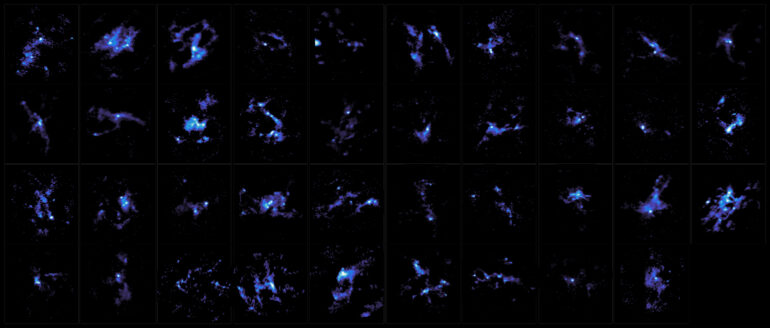Astronomers have mapped 39 interstellar clouds where high-mass stars are expected to form. This large data set shows that the accepted model of low-mass star formation needs to be expanded to explain the formation of high-mass stars. This suggests the formation of high-mass stars is fundamentally different from the formation of low-mass stars, not just a matter of scale.
High-mass stars play an important role in the evolution of the universe through the release of heavy elements and the shock waves produced when a massive star explodes in a supernova. Despite their importance, the way massive stars form remains poorly understood due to their rarity.
To better understand massive star formation a team led by Kaho Morii, Patricio Sanhueza, and Fumitaka Nakamura used the Atacama Large Millimeter/submillimeter Array (ALMA) to observe 39 infrared dark clouds (IRDCs). IRDCs are massive, cold, and dense clouds of gas and dust; and are thought to be the sites of massive star formation. The team focused on clouds showing no signs of star formation, to understand the beginning of the formation process before young stars ignite. In the 39 clouds, the team found more than 800 stellar seeds, referred to as molecular cloud cores, which astronomers think will evolve into stars.
Their results were published in an article titled, “The ALMA Survey of 70μm Dark High-mass Clumps in Early Stages (ASHES). IX. Physical Properties and Spatial Distribution of Cores in IRDCs,” in The Astrophysical Journal on June 20, 2023.
Of these cores, 99% lack enough mass to become high-mass stars, assuming that high-mass stars evolve in the same way as the better understood low-mass stars. These findings support the idea that the formation mechanism for high-mass stars must be different from that of low-mass stars.
Furthermore, the team investigated the distribution of cores. In stellar clusters, high-mass stars are grouped together, while low-mass stars are widely distributed. However, this work revealed that the locations of higher-mass cores exhibit no preference compared to the positions of lower-mass cores. On the other hand, denser cores tend to be locally concentrated. This suggests that denser cores rather than more massive cores may be the progenitors of high-mass stars; and that denser cores may grow more efficiently than less-dense cores.
More information:
Kaho Morii et al, The ALMA Survey of 70 μm Dark High-mass Clumps in Early Stages (ASHES). IX. Physical Properties and Spatial Distribution of Cores in IRDCs, The Astrophysical Journal (2023). DOI: 10.3847/1538-4357/acccea
Provided by
National Astronomical Observatory of Japan
Citation:
Observations of high-mass star seeds defy models (2023, June 20)


